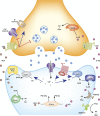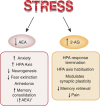Neurobiological Interactions Between Stress and the Endocannabinoid System
- PMID: 26068727
- PMCID: PMC4677118
- DOI: 10.1038/npp.2015.166
Neurobiological Interactions Between Stress and the Endocannabinoid System
Abstract
Stress affects a constellation of physiological systems in the body and evokes a rapid shift in many neurobehavioral processes. A growing body of work indicates that the endocannabinoid (eCB) system is an integral regulator of the stress response. In the current review, we discuss the evidence to date that demonstrates stress-induced regulation of eCB signaling and the consequential role changes in eCB signaling have with respect to many of the effects of stress. Across a wide array of stress paradigms, studies have generally shown that stress evokes bidirectional changes in the two eCB molecules, anandamide (AEA) and 2-arachidonoyl glycerol (2-AG), with stress exposure reducing AEA levels and increasing 2-AG levels. Additionally, in almost every brain region examined, exposure to chronic stress reliably causes a downregulation or loss of cannabinoid type 1 (CB1) receptors. With respect to the functional role of changes in eCB signaling during stress, studies have demonstrated that the decline in AEA appears to contribute to the manifestation of the stress response, including activation of the hypothalamic-pituitary-adrenal (HPA) axis and increases in anxiety behavior, while the increased 2-AG signaling contributes to termination and adaptation of the HPA axis, as well as potentially contributing to changes in pain perception, memory and synaptic plasticity. More so, translational studies have shown that eCB signaling in humans regulates many of the same domains and appears to be a critical component of stress regulation, and impairments in this system may be involved in the vulnerability to stress-related psychiatric conditions, such as depression and posttraumatic stress disorder. Collectively, these data create a compelling argument that eCB signaling is an important regulatory system in the brain that largely functions to buffer against many of the effects of stress and that dynamic changes in this system contribute to different aspects of the stress response.
Figures



References
-
- Aguado T, Monory K, Palazuelos J, Stella N, Cravatt B, Lutz B et al (2005). The endocannabinoid system drives neural progenitor proliferation. FASEB J 19: 1704–1706. - PubMed
-
- Aliczki M, Balogh Z, Tulogdi A, Haller J (2012). The temporal dynamics of the effects of monoacylglycerol lipase blockade on locomotion, anxiety, and body temperature. Behav Pharmacol 23: 348–357. - PubMed
Publication types
MeSH terms
Substances
Grants and funding
LinkOut - more resources
Full Text Sources
Other Literature Sources
Medical

